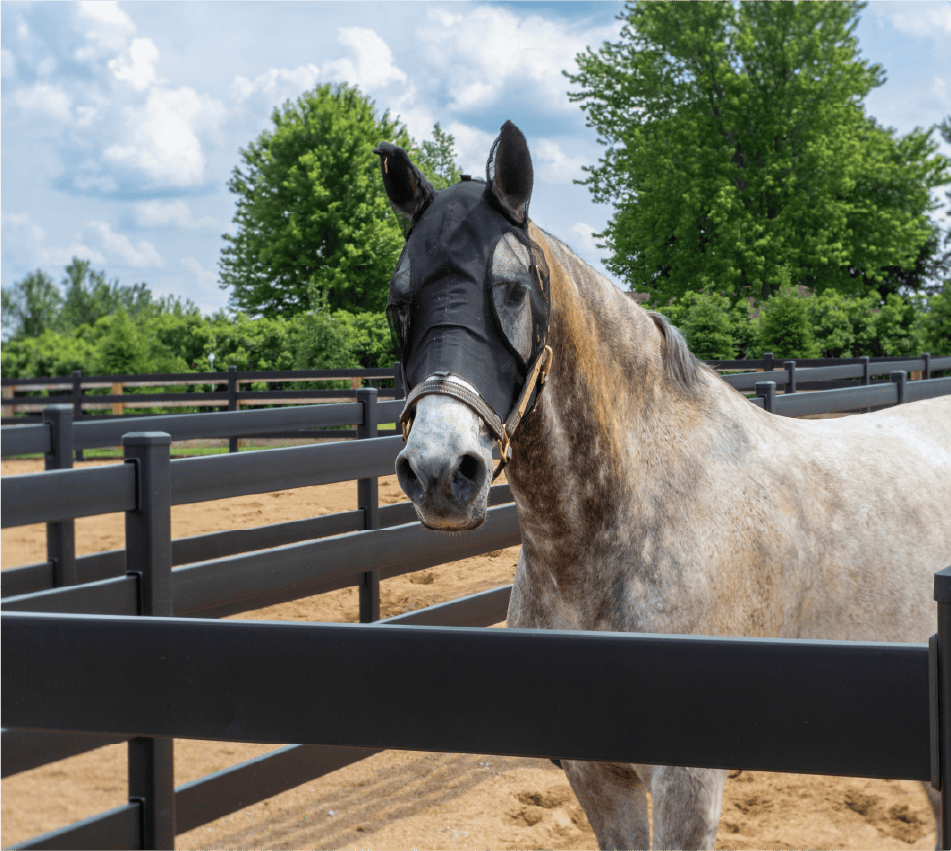As ranchers and farmers, we all know the importance of good fencing. It’s not just about keeping our horses in—it’s about keeping them safe. But let’s face it, with all the daily demands of running a farm or ranch, fencing often becomes an afterthought. That is, until something goes wrong.
We’ve been in this business for a long time, and we’ve seen firsthand the problems that can arise from inadequate fencing options. Splintering wood, protruding nails, gaps that seem to invite curious hooves—these are real issues that can lead to serious injuries and costly vet bills.
And let’s not even get started on the headaches that come with constant repairs and maintenance.
That’s why we developed Buckley Fence. We wanted to create a fencing solution that addresses the real-world problems faced by horse owners, ranchers, and farmers. Something that combines durability with safety, and doesn’t require you to be out there every other week with a hammer and nails.
Below, we’ll take a hard look at why proper fencing matters, the risks associated with cutting corners, and how our Buckley steel board fence system tackles these challenges head-on. Whether you’re managing a small farm or a large ranch, we’ll show you how to keep your equine partners safe while making life a little easier in the process.
Common Fencing Hazards for Horses
Let’s break down some of the most common hazards of different fence types:
- Splintering Wood: We’ve all been there—that old wooden fence that’s served us well for years suddenly becomes a hazard. Sun, rain, and curious horses can turn sturdy boards into splinter factories. These splinters aren’t just painful—they can cause serious infections if they get under a horse’s skin.
- Loose or Protruding Nails: It starts innocently enough—a board comes loose, and suddenly you’ve got nails sticking out at all angles. These silent menaces can cause nasty cuts or puncture wounds, often in areas that are hard to treat.
- Sharp Edges on Metal Fences: Metal fences seem like a durable option, but they come with their own risks. Exposed edges can become razor-sharp over time, especially if they start to rust. One wrong move, and you’re looking at a serious laceration.
- Gaps and Spaces: Horses are curious creatures, and they seem to have a knack for finding the one spot in your fence that’s just wide enough to trap a hoof. These gaps can lead to panic and severe injuries as the horse tries to free itself.
- Electrical Fencing Risks: While electric fences can be effective, they’re not without drawbacks. Inconsistent current, frayed wires, or a spooked horse can all lead to problems. Horses can crash right through these barriers when startled, leading to injuries and escapes.
- Inadequate Visibility: This is a subtle one, but crucial. Horses don’t have the best depth perception, especially at night or in low light. Fences that are hard to see can lead to collisions, particularly when horses are running or playing.
The real challenge is that many of these hazards develop over time. A fence that was perfectly safe when installed can become dangerous as it ages or as horses test its limits. That’s why regular inspections are essential, but let’s be honest—with everything else you have to manage, it’s easy for fence maintenance to slip down the priority list.
The Consequences of Unsafe Fencing
When we talk about fencing hazards, we’re not just dealing with hypotheticals. Unsafe fencing can (and will) impact horses, owners, and entire operations. Let’s break down the real-world consequences we’re facing:
- Physical Injuries to Horses: This is the most immediate and heart-wrenching consequence—everything from minor scrapes to severe lacerations, broken legs, and worse. These injuries aren’t just painful for the horses—they can end careers for performance animals or even be life-threatening. And let’s not forget: an injured horse is a horse that can’t work, whether that’s on the ranch or in the show ring.
- Psychological Stress on Animals: We sometimes overlook this, but horses that have had bad experiences with fencing can develop lasting anxiety. Horses can become nervous around any type of fence after a bad accident. This stress isn’t just bad for the horse’s well-being—it can make them unpredictable and harder to handle.
- Financial Costs for Owners: Emergency vet calls, ongoing treatments, potential surgeries—the costs can add up quickly. Owners can face bills running into thousands of dollars from a single fencing incident. And that’s not even counting the potential loss of income if we’re dealing with a working or competition horse.
- Legal Liabilities: If a horse escapes due to inadequate fencing and causes damage or injury to others, the owner can be held liable. Ranchers may face lawsuits after escaped horses cause something like a traffic accident. It’s a legal and financial nightmare none of us want to deal with.
- Time and Labor Costs: Every hour spent repairing fences is an hour not spent on other essential tasks. Constant maintenance doesn’t just eat into our time—it affects our bottom line when we have to pay for labor or materials for repeated repairs.
- Impact on Farm or Ranch Operations: An unreliable fence doesn’t just put horses at risk—it can disrupt entire operations. Escaped animals, fields that can’t be used due to unsafe fencing, delays in rotational grazing—these issues can throw off carefully planned schedules and affect productivity.
The reality is, the consequences of unsafe fencing ripple out far beyond just the immediate risk to your horses. They affect your time, finances, legal standing, and the overall efficiency of your operations.
Features of Safe Horse Fencing
After years in this business and countless conversations with ranchers and horse owners, we’ve come to recognize the essential features that separate truly safe horse fencing from the rest. Let’s break these down:
- Durability and Strength: A safe fence needs to withstand not just the weight of a horse leaning on it, but the impact of a full-grown horse potentially running into it at speed. The ideal fencing material should resist breaking, bending, or splintering under stress.
- Visibility: Horses don’t see the world quite like we do. A fence that’s clearly visible, day and night, significantly reduces the risk of collisions. This is especially crucial in low light conditions or for horses moving at speed. High-contrast colors or reflective elements can make a big difference here.
- Flexibility: A fence that has some ‘give’ to it is less likely to cause injury if a horse does run into it. Think of it like the crumple zone in a car—it absorbs impact rather than transferring all that force to the horse.
- Smooth Surfaces: Any protrusions, sharp edges, or rough surfaces are potential injury points. The ideal fence should be smooth to the touch all over. This includes not just the main fencing material, but also any joints, fasteners, or posts.
- Proper Height and Spacing: The fence needs to be tall enough to discourage jumping, but the spacing between rails is just as important. Too wide, and you risk a horse getting a leg caught between rails. Too narrow, and you might create a climbing hazard. The right balance depends on the size and breed of your horses.
- Weather Resistance: Our fences are out in the elements 24/7, facing everything from scorching sun to freezing rain. A safe fence needs to maintain its integrity year-round, without warping, rusting, or degrading in a way that creates hazards.
- Low Maintenance: Let’s be practical—the safer a fence is to begin with, the less we need to worry about constant repairs creating new hazards. A truly safe fencing system should remain safe with minimal intervention.
- Electrical Safety (if applicable): If you’re considering electric fencing, consistent and appropriate current is crucial. The shock should be enough to deter horses without causing harm, and the system needs to be reliable to prevent horses from testing it.
- Connectivity and Secure Closures: The joints and gates in a fence line are often the weak points. A safe fencing system needs secure connections between sections and gates that latch reliably to prevent escapes.
- Environmentally Sound: This might not seem directly related to horse safety, but it’s worth considering. Fencing that doesn’t leach harmful chemicals into the soil or water supply protects not just your horses, but your entire property’s ecosystem.
Buckley Fence: The Safest Choice for Horses
After years of seeing the shortcomings in traditional fencing options, we at Buckley Fence set out to create something truly revolutionary. Our Steel Board Fence system isn’t just another option on the market—it’s a comprehensive solution designed to address every major safety concern we’ve discussed.
At its core, Buckley Fence features a unique design that combines the strength of steel with the aesthetic appeal of traditional board fencing. But it’s more than just looks—let’s break down how our system tackles each safety concern:
- Durability and Strength: Our galvanized steel construction provides unmatched strength, capable of withstanding impacts that would splinter wood or warp vinyl.
- Visibility: The broad surface of our steel boards, available in high-contrast colors, maintains excellent visibility in all light conditions.
- Flexibility: Unlike rigid steel pipe fences, our fence has a degree of flex, absorbing impact to reduce injury risk.
- Smooth Surfaces: Every edge is rounded and smooth, with no protruding fasteners or sharp points.
- Weather Resistance: Our powder-coated finish resists rust, fading, and degradation, maintaining safety year after year with minimal maintenance.
- Safe Spacing: Engineered with optimal rail spacing to prevent trapped hooves while discouraging climbing or jumping.
Comparing Buckley Fence to Traditional Fencing Options
To truly appreciate the Buckley difference, let’s compare it to traditional fencing options:
Wood Fencing
While classic in appearance, wood fences require constant maintenance. They’re prone to splintering, rotting, and can harbor harmful bacteria. Buckley Fence provides the same classic look without these drawbacks, offering superior longevity and safety.
Vinyl Fencing
Vinyl fencing improves on wood’s maintenance issues but brings its own problems. It can become brittle in cold weather, sag in heat, and shatter on impact. Our steel construction maintains its integrity in all weather conditions and won’t shatter on impact.
Wire Fencing
Wire fences, including woven wire and high-tensile, are cost-effective but pose significant safety risks. They can cause severe cuts, and horses often get tangled in them. Buckley Fence eliminates these risks while providing superior containment.
Electric Fencing
While effective as a psychological barrier, electric fences aren’t physical barriers. Power outages or equipment failures can lead to escapes. Buckley Fence provides a consistent physical barrier without relying on electricity, eliminating these risks.
In every comparison, Buckley Fence stands out not just for what it offers, but for the problems it eliminates. We’ve taken the best aspects of traditional fencing—the strength of steel, the visibility of board fencing—and engineered out the drawbacks.
Prioritizing Horse Safety with Buckley Fence
The fencing you choose plays a crucial role in the safety, health, and well-being of your horses. It’s not just about containing them—it’s about creating an environment where they can thrive without unnecessary risks.
As fellow horse owners and ranchers, we understand the challenges you face. Every day, you’re balancing the needs of your animals with the practical realities of running a farm or ranch. That’s why we developed Buckley Fence—to give you one less thing to worry about.
With Buckley Fence, you’re not just buying a product: you’re investing in peace of mind. You’re choosing a fencing solution that will keep your horses safe year after year, with minimal maintenance and maximum durability.
Don’t wait for an accident to happen. Proactively choose the safest option for your horses. Contact us today to start your journey towards safer, more durable horse fencing.



